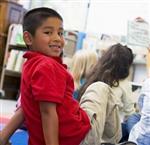- Trillium Creek Primary
- World Language
Curriculum
Page Navigation
World Language Program
-
At Trillium Creek Primary School, all students receive instruction in Spanish, our chosen world language. We believe that the study and acquisition of another language and culture enables us to interact and communicate with others, develop greater cognitive and critical thinking skills, have an appreciation and respect for other cultures, and be better able to obtain subsequent languages in the future. Included below is information about our World Language Program and how we are implementing it here at Trillium Creek.
Frequently Asked Questions
 Why is it important for students to learn a second language?
Why is it important for students to learn a second language?There is now at least two decades of research on the benefits of second language acquisition in terms of cognitive benefits, academic achievement and development of positive attitudes toward cultural diversity. The nation’s growing diversity and the growing global demand for cultural proficiency and linguistic adaptability, adds to the rationale for ensuring that our K-12 World Language program prepares each of our students to reach their potential and access every door of opportunity.
Why start learning a second language at a young age?
Learning a second or third language at a young age is the optimal time for two reasons:
- Language Proficiency: Starting earlier acknowledges early language acquisition mechanisms, promotes longer learning, practice and experience leading to greater fluency and effectiveness
- Cultural Proficiency: Children begin to move from egocentricity to reciprocity before the age of ten
What is the model for World Language study in our primary schools?
Starting in the fall of 2012, we will have three programs of second language acquisition in our primary schools:
- World Language Study in Spanish or Chinese – for all primary children in all nine of our primary schools
- English Language Study – for students learning English as a second language
- Dual Language Study in Spanish – for children learning a second language through a K-5 50-50 immersion model. This program is currently offered in two of our primary schools, Trillium Creek and Lowrie.
How will the World Language study model look in each primary school?
Children at each primary school will acquire their second language through language instruction provided by a fluent instructor once a week and additional web-based instruction provided once or twice a week.
G.K-1:
- Fluent Instructor 1x/week - conversations & culture, language usage
- Classroom teacher & students learn together through music, poems, chants, digital resources, classroom books
G. 2-5:
- Fluent Instructor 1x/week – conversations & culture, language usage
- Classroom teacher & students learn together through web-based language instruction (e.g. Rosetta Stone) 1-2x/week, music, poems, chants, digital resources, classroom books
School-wide Focus
- (calendar, labels, signs, integration of lessons)
- Language visibility in school common areas
- Morning Meeting practice
- Cultural assemblies
- Native-language speaking guests
- Hallmark experiences at each grade band
- High school student language tutors and models
- Heritage celebrations
- Music program integration
- Sister-School relationships
How will this additional instruction fit into the school day?
Our primary schools are expected to teach Spanish at each grade level (G. 1-5) during the school day and school week; therefore, this renewal is not about an additional expectation. Currently, instructional delivery has varied across the schools. Renewing and better resourcing our World Language program enables us to recommit to that time and provide language instruction that is consistent and aligned across the grade levels and schools. We believe that learning a second language is value-added for academic, cognitive and social gains. Teachers and principals will work creatively and collaboratively to integrate opportunities for language learning meaningfully during the flow of the school day.
Will our school technology be reliable to support a web-based language instruction program (i.e. Rosetta Stone)?
Yes. Our IT Director has previewed the Rosetta Stone web-based instructional program (as one viable option). Its capacity requirements are compatible with our current technology hardware. The only caution is in using iPads, as some web-based applications do not fully support all of a program’s components. Visits to neighboring schools using web-based language instruction (which happened to be Rosetta Stone) provided strong evidence of students’ ability and ease with logging on, accessing their account, and learning without interruption. Headsets with microphones are recommended for maximum engagement and benefit.

